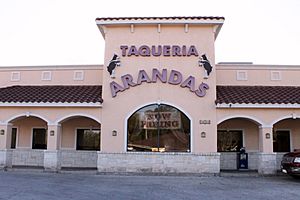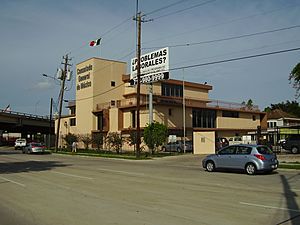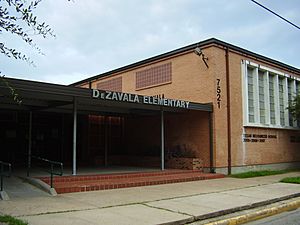History of Mexican Americans in Houston facts for kids
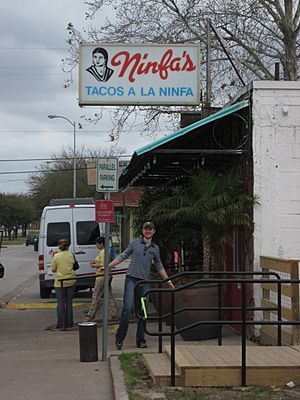
Houston is home to many people of Mexican heritage. This includes Mexican Americans, Mexican immigrants, and Mexican citizens living abroad. People of Mexican origin are the oldest Hispanic group in Houston. As of 2007, they were considered the most "well-established" Spanish-speaking group in the city. Houston is the third most popular city for Mexican immigrants in the United States, after Chicago and Los Angeles.
Contents
History of Mexican Americans in Houston
Early Beginnings and Immigration (Early 1900s)
When Houston was founded in 1836, some Mexican prisoners of war helped clear the land. They drained swamps so the city could be built. Some of these prisoners were given land and became servants. For most of the 1800s, most Mexican immigrants went to places like the Rio Grande Valley, El Paso, and San Antonio. They did not often come to East Texas cities like Houston.
In East Texas, many non-Hispanic white settlers had a culture similar to the Deep South. They preferred to hire African American and white sharecroppers. One author, Robert R. Treviño, said that these settlers "made it clear that Mexicans were not welcome." Between 1850 and 1880, only a small number of Mexicans lived in Houston. In 1880, the U.S. Census showed only a "handful" of Mexicans in the city.
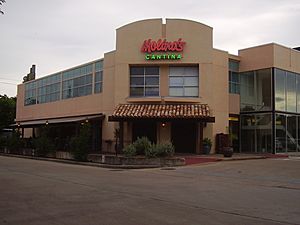
Mexican immigration to Houston grew as the railroad system expanded. Also, Porfirio Díaz became the President of Mexico. Many Mexicans who were unhappy with Díaz used the railroads to travel to Texas. In the late 1800s and early 1900s, Mexican Americans and immigrants from Mexico began to settle permanently in Houston. Many worked in jobs that did not require special skills or as food sellers.
By 1900, about 500 people of Mexican origin lived in Houston. This number grew to 2,000 by 1910. In 1907, a cultural committee called a junta patriótica started Mexican Independence Day celebrations. By 1908, at least one Mexican American mutual aid society had formed. These groups helped people in the community.
Growth and Challenges (Early 20th Century)
The Mexican population in Houston grew even more in the early 1900s. The Mexican Revolution in 1910 caused many Mexicans to move to Houston. Employers also hired Mexican Americans as enganchadores (labor agents) to recruit more workers. These agents brought in more Mexican Americans and immigrants.
Many Mexican Americans in rural areas lost their jobs as large-scale farming increased. They moved to Houston because its economy was growing. During World War I, there was a shortage of workers, which encouraged more Mexicans to work in Houston. Also, immigration rules made in the 1920s did not affect Mexicans, so they continued to arrive.
The demand for workers came from building the Houston Ship Channel and railroads. There was also agricultural work in areas around Houston. By 1920, Houston had 6,000 residents of Mexican origin. This number grew to about 15,000 by 1930.
Mexicans first settled in the Second Ward. This area quickly became the center of their cultural and social life. Magnolia Park also started to attract Mexican immigrants in the 1920s. Over time, Mexicans moved to other neighborhoods like the First Ward, the Sixth Ward, the Northside, and the Houston Heights.
By 1930, Houston's Mexican population was almost double the number of immigrants from Eastern and Southern Europe. The Mexican American community became an important part of Houston's society, which had mostly been seen as black and white. Even though their numbers were smaller than in cities like San Antonio or Los Angeles, Mexicans stood out in Houston.
During the Great Depression, Houston city officials blamed Mexican Americans for economic problems. They pressured Mexican immigrants to leave Houston. Many Mexican Americans did not receive government help meant to ease the effects of the Depression. About 2,000 Mexicans left Houston during this time. However, some Mexican American groups, like the Our Lady of Guadalupe Church and the Sociedad Mutualista Obrera Mexicana, offered help to the community.
Later Immigration (Late 20th and 21st Centuries)

In the late 1970s and early 1980s, tens of thousands of Mexicans came to Houston. This was because the oil business was booming, creating many job opportunities. In the 1970s, 63,000 Mexicans arrived in the Houston area. Many of these newer immigrants found work in informal jobs. Most Mexicans in this wave came from states along the U.S.-Mexico border, such as Coahuila, Nuevo León, and Tamaulipas.
In 1980, the U.S. census showed that 93,718 Mexicans in Houston were born outside the United States. About 68% of them had immigrated since 1970.
Mexican immigration to Houston changed due to the oil bust in the 1980s. The oil bust caused job losses for many Mexicans in the area. Some Mexicans moved to other U.S. cities to find work. In 1986, a federal law was passed that made it harder for employers to hire immigrants without proper documents.
Despite these changes, 89,000 Mexicans arrived in Harris County during the 1980s. After 1987, when the oil bust ended, wages did not grow much, and job growth was slow. The Immigration Reform and Control Act (IRCA) offered a chance for some immigrants who arrived before 1982 to become legal residents. This law also fined employers who hired immigrants without proper documents.
In 1990, there were 132,596 Mexican immigrants in Houston. They made up 69% of all foreign-born Hispanic residents. That year, 46% of all immigrants to Houston were Mexican. In Harris County in 1990, the average household income for ethnic Mexicans was $22,447. Only 6% of ethnic Mexicans had a college degree or higher education. This showed a big difference in education and partly explained the lower average income.
From 1990 to 1997, the number of Mexican immigrants in Houston grew by over 110,000. In the 1990s, a strong economy in the U.S., problems in Mexico's economy, and thousands of newly legal immigrants bringing their families encouraged more Mexican immigration.
As of 2007, most of the Hispanic political leaders in Houston were Mexican Americans.
Media and News
Some of the first Mexican-American newspapers in Houston included El Anunciador, La Gaceta Mexicana, El Tecolote, and La Tribuna. These newspapers helped share news and information within the community.
Religion
Historically, many Mexican immigrants came from areas where traditional folk religion was common. This sometimes differed from the existing American Catholic practices.
In 1910, there were no Catholic churches specifically for Mexicans in Houston. Some Mexicans were not allowed to attend Anglo (white) Catholic churches, and those who did often faced unfair treatment. In 1911, the Roman Catholic Diocese of Galveston brought in priests called Oblates of Mary Immaculate to serve the Mexican population.
In 1912, Our Lady of Guadalupe Catholic Church opened. It was the first Mexican Catholic church in Houston. As more people needed Catholic services, these priests started missions in different Mexican-American neighborhoods. The Catholic church created Our Lady of Guadalupe so that white people, who were used to racial separation, would not be upset by Mexicans in their churches. The second Mexican Catholic church, Immaculate Heart of Mary Catholic Church, opened in the 1920s.
Over time, more churches started by Mexicans opened. As some neighborhoods became mostly Mexican, these churches became Mexican churches.
In 1972, Catholic leaders and Hispanic community members in Houston held an event called the Encuentro Hispano de Pastoral (Pastoral Congress for the Spanish-speaking). This event was a very important moment in the religious history of Mexican American Catholics in Houston.
Diplomatic Offices
The Consulate-General of Mexico is located in Southeast Houston. This office helps Mexican citizens living in Houston and promotes ties between Mexico and the United States.
In Media
The 2011 novel What Can't Wait by Ashley Hope Pérez tells the story of a Mexican-American teenage girl. She is trying to balance her family's expectations with her own dreams for the future.
Notable Mexican Americans
- Mario Gallegos, Jr. – A politician from Texas.
- Marcario García – A military member from Sugar Land.
- Jim Goode – A restaurant owner who was partly of Mexican descent.
- Ninfa Laurenzo (Maria Ninfa Rodriguez Laurenzo) – The person who started Ninfa's restaurants.
- Lydia Mendoza – A famous singer.
- Rick Noriega – A politician.
- Ben Reyes – A politician.
- South Park Mexican (Carlos Coy) – A rapper.
- Chingo Bling (Pedro Herrera III) – A rapper and producer.
- Felix Tijerina – A restaurant owner, activist, and helper of the community.
- Gracie Saenz – A politician.
- Juan Díaz – A boxer.
- Carol Alvarado – A representative for a Texas state house district.
- Jennifer Reyna – A TV personality.
- Gwendolyn Zepeda – An author.
Education
In the 1900s, when schools were legally separated by race (during the Jim Crow era), Mexican Americans went to schools that were officially for white students. Until 1970, the Houston Independent School District (HISD) counted its Hispanic students as "white."
Some elementary schools in Houston started to have mostly Mexican American students in the 1900s. Lorenzo de Zavala Elementary School in Magnolia Park was the first school with a majority of Mexican American students. School leaders created De Zavala elementary to ease the worries of white parents who saw more Mexican students in white schools. In some schools, like Rusk Elementary School, Mexican students were put into separate classes. This was a form of unofficial segregation. At that time, there were no high schools with mostly Mexican American students.
The number of Hispanic students in Houston's public schools began to increase in 1937. After the 1960s, many high schools started to change from being mostly white to mostly Hispanic.
The AAMA organization operates George I. Sanchez Charter Schools, which serve many Hispanic students.
Transportation
As of 2007, there were at least 20 flights per day from Houston to Mexico City. There were also about 20 daily flights to other Mexican cities, making a total of about 40 flights each day.
Images for kids
-
The former location of the final Felix Mexican Restaurant, started by Mexican-American Felix Tijerina


